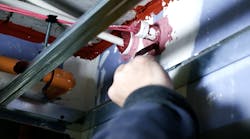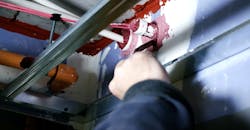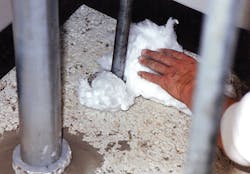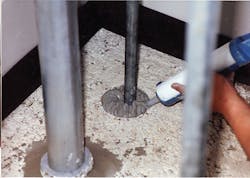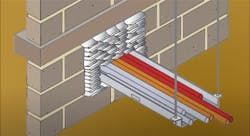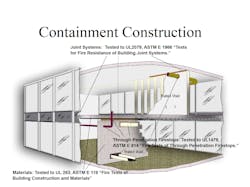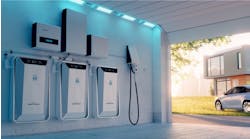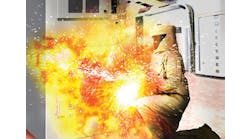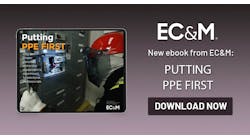Active fire protection refers to fire protection systems that require some action in order to function. These include fire sprinklers, fire alarms, mechanical smoke evacuation, and fire extinguishers. Passive fire protection, based largely on the concept of compartmentation, refers to structures that are built into a building to passively prevent or stop the spread of smoke and fire. Passive fire protection consists of smoke dampers, fire-rated walls, and fire doors.
The basics
With all of this protection, why are firestops needed? The trouble starts once electricity, water, HVAC, communications cabling, and other amenities are added to the building. All of these systems require you, as the contractor, to penetrate the building’s fire-rated walls and floors, effectively “de-rating” their protection. To bring a wall or floor back up to its original fire rating, UL-tested and -certified firestopping materials must be installed around the pipes, HVAC ducts, cables, cable trays, and other penetrants going through the hole. To do so, you can take one of several firestop approaches — or apply a combination of the following:
- Intumescent products come in the form of sealants, putty, pillows, tape, sheets, and strips, all of which expand when exposed to heat by as much as 25 times in volume while decreasing in density to form a high-strength, fire-resistive seal. Intumescent firestop is used mainly around pipes and cables that penetrate through walls and floors.
- Ablative firestop products are used to seal construction joints in a building where flames and smoke can spread, such as a gap between the floor and an exterior wall. Because joints are designed to allow movement, ablative firestop must be elastic to handle joint expansion and contraction, seismicity, and wind loads. Therefore, they are often made from silicon. Ablative firestop absorb the energy of a fire to protect what is underneath, buying valuable time. They work by consuming heat energy from fire and releasing it in the form of gases as they char to form insulation.
- Firestop collars or chokes protect plastic pipes penetrating fire-rated walls and floors. They protect the integrity of the firewall by using a heavy-gauge galvanized metal collar to house a molded intumescent insert.
- Insulative foil-encapsulated firestop products act as a barrier against heat and fire, helping to protect air, chemical, and grease ducts by wrapping completely around them.
- Endothermic fire-stopping protects through-penetrations, electrical cable trays, structural steel, and emergency circuitry. Available in mats, endothermic materials release molecules of water in the form of steam when exposed to heat, therefore providing a cooling effect and acting as a heat sink. Endothermic products are sacrificial, that is, given enough time, they char away, crumble, and disappear.
Mineral wool is often placed inside wall and floor cavities closed off by a firestop to assure the integrity of the fire-rated seal. The wool is simply cut and stuffed into the penetrations prior to firestop being installed. Mineral wool is a critical component in perimeter fire containment, floor and wall penetrations, construction joints, and other applications.
It is important to note that “firestopping” refers to a system, not a single product. Firestopping has three elements: the fire-rated walls, partitions, floors, or ceilings that have been penetrated; the cables, cable trays, or conduits that make up the object creating the penetration; and the materials used to seal the penetrations to prevent the spread of fire and smoke. Firestop material is just one part of this complete system that, when used together, has an Underwriter’s Laboratory (UL) and/or ASTM approval. If one of the three elements fails, the overall system is compromised.
There is also a common misconception in the industry that firestopping is the same as “fireproofing.” This is not true. Fireproofing refers to the spray-on material you see on the underside of steel fluted decks in multistory buildings, steel I-beams, structural support columns, and primary concrete. It typically is grayish in color with a rough texture. Fireproofing protects steel structures by insulating them from a high temperature fire, thus preventing the steel from warping, preserving its shape and strength.
Where there’s smoke…
Firestops prevent the spread of flames. More importantly, they stop deadly gases and toxic smoke from traveling through walls, floors, ceilings, and joints. Smoke and toxic gases are the leading killers of fire victims. Roughly 75% of building-related fire deaths are directly related to oxygen deprivation in the bloodstream, caused by the replacement of oxygen in the blood hemoglobin by carbon monoxide. During a fire, smoke can quickly travel a significant distance. In a developing fire, smoke will travel 50 ft to 100 ft per minute. In a fire that has developed, smoke may travel as fast as 300 ft per minute. The firestop is literally the last line of defense for building occupants and first responders.
Responsibilities and ratings
There are many parties responsible for ensuring a building is properly firestopped — from the building owner, architect, and specifier all the way to the general contractor, subcontractors, and code officials. Drywallers, HVAC technicians, electricians, plumbers, and datacom installers run service installations throughout buildings. Every opening and gap they create must be firestopped to restore the integrity of a fire-rated assembly.
Non-compliance can lead to serious legal issues. So, before walking away from a hole drilled into a wall, understand what the National Fire Protection Association (NFPA), International Building Codes (IBC), and National Electrical Code (NEC) requires:
As per Sec. 8.3.4.2.1 of the 2018 edition of NFPA 101, “Penetrations for cables, cable trays, conduits, pipes, tubes, combustion vents and exhaust vents, wires, and similar items to accommodate electrical, mechanical, plumbing, and communications systems that pass through a wall, floor, or floor/ceiling assembly constructed as a fire barrier shall be protected by a firestop system or device.”
As per Sec. 706.9 of the 2018 edition of the IBC, “Penetrations of firewalls shall comply with Section 714.” Also noted in Sec. 714.2, “A listed penetration firestop system shall be installed in accordance with the manufacturer’s installation instructions and the listing criteria.”
As per Sec. 300.21 of the 2020 edition of the NEC, “Electrical installations in hollow spaces, vertical shafts, and ventilation or air-handling ducts shall be made so that the possible spread of fire or products of combustion will not be substantially increased. Openings around electrical penetrations into or through fire-resistant-rated walls, partitions, floors, or ceilings shall be firestopped using approved methods to maintain the fire resistance rating.”
Testing
Approved firestop materials are tested to ASTM E-814 and/or UL 1479, “Fire Tests of Through-Penetration Firestops.” Building materials are tested to the nearly identical ASTM E 119 and/or UL 263 test method, “Fire Tests of Building Construction and Materials.” Both evaluate the ability of a fire-resistive floor or wall assembly to perform its barrier function, resisting the passage of heat, flames, hot gases, and smoke in a fire situation. “Fire Tests of Through Penetration Firestops,” or ASTM E 814, evaluates penetrations through a tested, fire-resistive (ASTM E 119 tested) wall or floor assembly. These standards contain the approved firestop system for building scenarios within the United States.
Although UL is the largest and most well-known testing agency, they are not the only lab permitted to test building materials and firestop materials. Other third-party labs can test to the ASTM standard and provide these approvals. Following are the testing standards for each specific purpose:
- Fire Tests of Through Penetration Firestops (ASTM E-814 and UL 1479)
- Tests for Fire Resistance of Building Joint Systems (ASTM E-1966 and UL 2079)
- Fire Tests of Building Construction and Materials (ASTM E-119 and UL 263)
When it comes to firestopping system requirements for your building, always consult the local Authority Having Jurisdiction (AHJ) for guidance. The AHJ could be either your local fire marshal or building code inspector.
Firestop listings
Like a fire-rated wall, a firestop must be “listed” and “labeled” for use as such. Just as with opening protectives, it must be rated to match the fire-resistance rating of the wall or another surface that is being penetrated.
In North America, these ratings are typically listed as “F” ratings and “T” ratings. The F rating refers to the amount of time that it will take for a fire to break through from the exposed side to the non-exposed side of the fire-rated wall or assembly. The T rating refers to the time it takes for the penetrating item to heat to 325°F plus ambient temperature. NFPA 101 requires that each of these ratings be no less than 1 hour — again, they must at least match the rating of the barriers that protect the overall compartment.
Additionally, an “L” rating shows the effectiveness of the firestop as a smoke and toxic gas barrier. It rates the air leakage in cubic feet per minute per square foot of opening (CFM/sq ft). The “W” rating refers to water-resistant and/or watertight seal. It indicates the effectiveness of the firestop material in restricting the flow of water through penetrations in ceilings, floors, and walls occurring from exposure to the elements.
In some situations — particularly, mechanical, electrical, and plumbing applications in industrial plants insured by FM Global — it is necessary to have FM-approved firestop installations. This typically requires two types of documents: one showing that the manufacturer is subject to FM’s quality inspection program and one proving the firestop system is tested under UL/ASTM standards.
Selecting firestop systems
To select the proper firestop system, you must know several pieces of information, including:
- Assembly type. What type of construction is being penetrated? Is it a wall, floor, or ceiling? Is it constructed of concrete, wood, or other material?
- Penetrating item. What kind of item is being pushed through the wall? Is it electrical cabling, a metal pipe, a plastic pipe, an air duct, or a combination of items? Each of these items reacts differently during a fire. Knowing this will help you select the correct firestop products.
- Required rating. What is the fire-resistance rating of the assembly being penetrated?
- Size of the penetrating item. Firestopping a 2-in. pipe requires far different products compared to a large cable tray or grease duct.
- Optional sleeve. In some assemblies, a steel sleeve is required; in others, it is optional.
- Cable fill. This refers to the size and types of cables that are being installed through the penetration.
- Joint width and movement. A joint is a division that allows independent movement of the building. Knowing the width and movement requirements is necessary to choose the right system detail.
- Annular space. This refers to the distance between the edge of the opening and the item penetrating the wall or floor.
Permanent or temporary?
When moving forward with an installation, you must decide whether the penetration will be permanent for the life of the building. Rarely is this the case, as things always seem to change. For example, expansion of a tenant’s office may require new electrical wiring to support additional workstations, or an IT network may add new cable drops. Communications technology changes quickly, so it is likely a retrofit will occur every three to five years. Even water pipes and HVAC ducts must be moved in major renovation projects. In short, whatever is installed in the firestopped walls will likely be changed in the future.
Every time a cable is added or removed, you must take out and replace the caulk, mortar, or putty firestop just as you found it. Since this can be both messy and time-consuming, manufacturers offer products for jobs that require frequent re-penetration: firestop bricks/blocks or pillows and multi-cable systems allow you to easily remove and re-install cables.
What about electrical boxes?
This is a very common question. According to the International Building Code (IBC 2012 714.3.1), membrane penetrations (one-sided breaches) by electrical boxes may not require a firestopping assembly if they’ve been tested for use in a fire resistance-rated assembly — and if they are installed per their listing or meet all of the following conditions:
- The electrical box area does not exceed 16 sq in.;
- The aggregate area of openings through membrane does not exceed 100 sq in. in any 100 sq ft of wall area;
- The annular space between the wall membrane and the box does not exceed 1/8 in.; and
- If located on opposite sides of the wall, electrical boxes are separated by 24 in. in different stud cavities.
If these conditions are not satisfied, then additional insulation, fireblocking, or listed firestop assemblies need to be added to achieve compliance with the code.
Final thoughts
Modern firestopping has been around for 40 years — or to be more precise, since Nov. 21, 1980. That is the date of the MGM Grand fire in Las Vegas where 85 people died and 679 were injured, including guests, employees, and 14 firefighters. On that day, burning material created toxic fumes that ascended throughout the hotel tower via vertical shafts and seismic joints, causing most of the deaths. As a result of the fire, fire safety professionals and insurance companies became a driving force behind promoting and developing stronger building codes that require fire-stopping.
While the importance of a firestop system is recognized today by experts in the field of fire safety, it needs to be a top priority among building owners and those involved in the construction industry. Firestop is a huge advantage to the builder, owner, and management. If properly installed, it will greatly limit or eliminate the risk of fire, smoke, and toxic gases spreading throughout an entire building, therefore preventing damage to the structure, personal property, and, most of all, people in the building.
Pierce is a senior engineering technician at Emerson Automation Solution's Nelson Firestop. He has nearly two decades experience in fire stop engineering and safety training and can be reached at [email protected].
